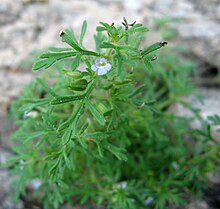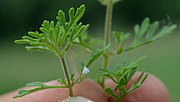| Leucospora multifida | |
|---|---|

| |
|
Scientific classification
| |
| Kingdom: | Plantae |
| Clade: | Tracheophytes |
| Clade: | Angiosperms |
| Clade: | Eudicots |
| Clade: | Asterids |
| Order: | Lamiales |
| Family: | Plantaginaceae |
| Genus: |
Leucospora Nutt. |
| Species: | L. multifida
|
| Binomial name | |
| Leucospora multifida (
Michx.) Nutt.
| |
| Synonyms [1] | |
| |
Leucospora multifida, known variously as Obi-Wan conobea, narrow-leaved paleseed, cliff conobea, cut-leaved conobea, or much-cleft conobea, is an annual herb in the plantain family, Plantaginaceae, and the only species in the North American genus Leucospora. [2] [3] [4] [1]
The genus Leucospora, from the Greek for "white-seeded", was named in 1834 by English botanist Thomas Nuttall. [2] [5] Its sole species (as of July 2019 [update]), now known as Leucospora multifida, was first described in 1803 by French botanist André Michaux as Capraria multifida. [6] The epithet multifida is Greek for "cleft many times", in reference to the shape of its leaves. [2] It has since been placed in several different genera, including Leucospora, Stemodia, Sutera, and Conobea, the latter from which several of its vernacular names originate. [6]
One of its vernacular names, Obi-Wan conobea, is a reference to the Star Wars character Obi-Wan Kenobi, and is sometimes considered as purely a joke snuck into the 1994 edition of the Plants of the Chicago Region. However, this actually was a name in use by regional botanists at the time, "the kind of jocular lingo that arises among field botanists working in humid, hot summer sun and bedeviled by all manner of unpleasant flying and crawling things". [2]
Obi-wan conobea is a small plant, growing to around 20 cm (8 in) tall, with glandular-hairy foliage. [7] Its deeply dissected leaves may be alternate, opposite, or whorled. [2] [7] The axillary flowers are borne on pedicels. Each pale, lavender flower is tubular, around 6 mm (1⁄4 in) with 5 lobes. It flowers in the mid-summer to fall. [2] [7]
The core of its native range is the midwestern United States, including most of Illinois and Missouri, extending west to Nebraska, south to Texas, and east to Ohio, with scattered occurrences beyond, where it may be adventive. [3] [8]
Leucospora multifida is a facultative wetland or obligate wetland plant across its range. [9] It grows on sandy, gravelly, and marly soils in ditches, swales, and receding shorelines of rivers and streams. [2]
- ^ a b "Leucospora Nutt". Plants of the World Online. Royal Botanical Gardens Kew. Retrieved 27 July 2019.
- ^ a b c d e f g Wilhelm, Gerould; Rericha, Laura (2017). Flora of the Chicago Region: A Floristic and Ecological Synthesis. Indiana Academy of Sciences.
- ^ a b USDA, NRCS (n.d.). "Leucospora multifida". The PLANTS Database (plants.usda.gov). Greensboro, North Carolina: National Plant Data Team. Retrieved 27 July 2019.
- ^ Brouillet L, Desmet P, Coursol F, Meades SJ, Favreau M, Anions M, Bélisle P, Gendreau C, Shorthouse D, et al. (2010). "Leucospora multifida". Database of Vascular Plants of Canada (VASCAN). Retrieved 27 July 2019.
- ^ "Leucospora Nutt". ipni.org. International Plant Names Index. Retrieved 27 July 2019.
- ^ a b "Capraria multifida Michx". ipni.org. International Plant Names Index. Retrieved 27 July 2019.
- ^ a b c "Obe-Wan-Conobea (Leucospora multifida)". www.illinoiswildflowers.info. Retrieved 28 July 2019.
- ^ Weakley, Alan S. (2018), Flora of the Southern and Mid-Atlantic States, working draft of 20 August 2018, University of North Carolina Herbarium, North Carolina Botanical Garden, University of North Carolina at Chapel Hill
- ^ "NWPL Species v3.3-f9b". wetland-plants.usace.army.mil. Retrieved 27 July 2019.
| Leucospora multifida | |
|---|---|

| |
|
Scientific classification
| |
| Kingdom: | Plantae |
| Clade: | Tracheophytes |
| Clade: | Angiosperms |
| Clade: | Eudicots |
| Clade: | Asterids |
| Order: | Lamiales |
| Family: | Plantaginaceae |
| Genus: |
Leucospora Nutt. |
| Species: | L. multifida
|
| Binomial name | |
| Leucospora multifida (
Michx.) Nutt.
| |
| Synonyms [1] | |
| |
Leucospora multifida, known variously as Obi-Wan conobea, narrow-leaved paleseed, cliff conobea, cut-leaved conobea, or much-cleft conobea, is an annual herb in the plantain family, Plantaginaceae, and the only species in the North American genus Leucospora. [2] [3] [4] [1]
The genus Leucospora, from the Greek for "white-seeded", was named in 1834 by English botanist Thomas Nuttall. [2] [5] Its sole species (as of July 2019 [update]), now known as Leucospora multifida, was first described in 1803 by French botanist André Michaux as Capraria multifida. [6] The epithet multifida is Greek for "cleft many times", in reference to the shape of its leaves. [2] It has since been placed in several different genera, including Leucospora, Stemodia, Sutera, and Conobea, the latter from which several of its vernacular names originate. [6]
One of its vernacular names, Obi-Wan conobea, is a reference to the Star Wars character Obi-Wan Kenobi, and is sometimes considered as purely a joke snuck into the 1994 edition of the Plants of the Chicago Region. However, this actually was a name in use by regional botanists at the time, "the kind of jocular lingo that arises among field botanists working in humid, hot summer sun and bedeviled by all manner of unpleasant flying and crawling things". [2]
Obi-wan conobea is a small plant, growing to around 20 cm (8 in) tall, with glandular-hairy foliage. [7] Its deeply dissected leaves may be alternate, opposite, or whorled. [2] [7] The axillary flowers are borne on pedicels. Each pale, lavender flower is tubular, around 6 mm (1⁄4 in) with 5 lobes. It flowers in the mid-summer to fall. [2] [7]
The core of its native range is the midwestern United States, including most of Illinois and Missouri, extending west to Nebraska, south to Texas, and east to Ohio, with scattered occurrences beyond, where it may be adventive. [3] [8]
Leucospora multifida is a facultative wetland or obligate wetland plant across its range. [9] It grows on sandy, gravelly, and marly soils in ditches, swales, and receding shorelines of rivers and streams. [2]
- ^ a b "Leucospora Nutt". Plants of the World Online. Royal Botanical Gardens Kew. Retrieved 27 July 2019.
- ^ a b c d e f g Wilhelm, Gerould; Rericha, Laura (2017). Flora of the Chicago Region: A Floristic and Ecological Synthesis. Indiana Academy of Sciences.
- ^ a b USDA, NRCS (n.d.). "Leucospora multifida". The PLANTS Database (plants.usda.gov). Greensboro, North Carolina: National Plant Data Team. Retrieved 27 July 2019.
- ^ Brouillet L, Desmet P, Coursol F, Meades SJ, Favreau M, Anions M, Bélisle P, Gendreau C, Shorthouse D, et al. (2010). "Leucospora multifida". Database of Vascular Plants of Canada (VASCAN). Retrieved 27 July 2019.
- ^ "Leucospora Nutt". ipni.org. International Plant Names Index. Retrieved 27 July 2019.
- ^ a b "Capraria multifida Michx". ipni.org. International Plant Names Index. Retrieved 27 July 2019.
- ^ a b c "Obe-Wan-Conobea (Leucospora multifida)". www.illinoiswildflowers.info. Retrieved 28 July 2019.
- ^ Weakley, Alan S. (2018), Flora of the Southern and Mid-Atlantic States, working draft of 20 August 2018, University of North Carolina Herbarium, North Carolina Botanical Garden, University of North Carolina at Chapel Hill
- ^ "NWPL Species v3.3-f9b". wetland-plants.usace.army.mil. Retrieved 27 July 2019.

